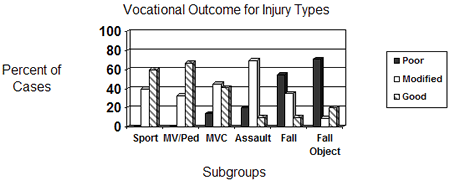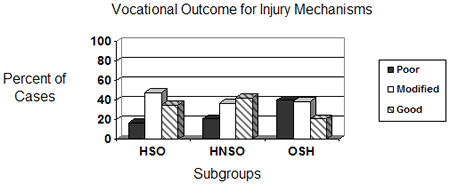Neuropsychological outcome in mild traumatic brain injury (MTBI) is difficult to predict. In this study researchers looked at one hundred MTBI cases consecutively referred to a concussion clinic. The researchers sought to study the relationship of two variables, mechanism of injury and type of injury, to vocational outcome and neuropsychological status.
Three different injury mechanisms were studied:
Examples of type of injury include: falls, sports/recreation, falling object, assault, motor vehicle accident, and motor vehicle-pedestrian collisions.
Since the study sample came from consecutive referrals as opposed to selected cases, three to forty months had elapsed since the injury occurred. The average age of patients was 35.6 years. All participants met diagnostic criteria for MTBI as defined by the American Congress of Rehabilitation Medicine. 78 were CT and/or MRI negative, 22 were positive. Loss of consciousness at the time of injury had occurred in 49 patients, and there was no loss of consciousness in 51. Upon referral to the clinic all patients were subject to thorough neuropsychological testing.
The authors found that neither positive CT scans or brief loss of consciousness appeared to be significant factors in predicting neuropsychological status or vocational outcome. Vocational outcome did not differ between males vs. females, prior concussion vs. no prior concussion, and psychiatric history vs. no psychiatric history. Interestingly, litigation also had no effect on vocational outcome. There was a significant difference in vocational outcome when comparing injury types. Those injured in falls, or by falling objects had significantly worse vocational outcomes than did those injured in motor vehicle collisions. The chart below illustrates:

Vocational outcomes in relationship to injury mechanisms showed that those injured by an object striking the head (OSH) had significantly worse outcomes than the head striking object (HSO) group. A similar trend for OSH and head not striking object (HNSO) was observed, but statistical significance could not be assessed because of sample size. The researchers found no difference in the HSO and HNSO groups. The following chart illustrates the results:

The authors found that acute injury characteristics, mechanism of injury and type of injury can be useful in predicting vocational/functional outcome and cognitive status after MTBI. They state:
"In conclusion, the present study supports the view that some acute injury characteristics may be used to classify subtypes of MTBI patients. The findings also underscore the importance of obtaining detailed and accurate information about what actually happened at the time of the injury from eyewitness reports and paramedic reports. Given the present findings, such information is important to the clinician, who is often asked to offer predictions of outcome and provide coordination of services."
Hanlon R, Demery J, Martinovich Z, Kelly J. Effects of acute injury characteristics on neuropsychological status and vocational outcome following mild traumatic brain injury. Brain Injury 1999;13(11):873-887